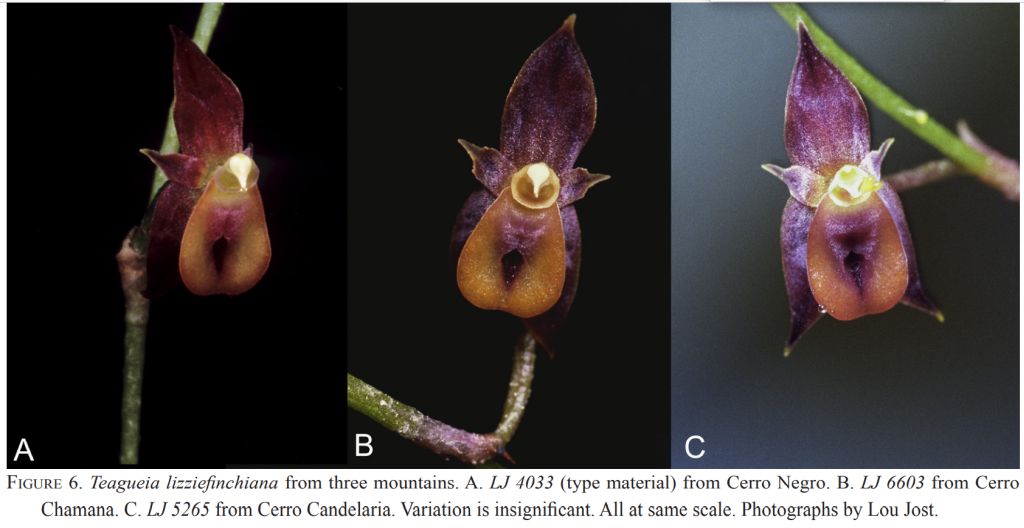

Teagueia lizziefinchiana L.Jost & Shepard 2017
Comparison photo of flowers between T lizziefinchiana and T jostii
Photos/TYPE Drawing by © Lou Jost

 LATE
LATE


Common Name Lizzie Finch's Teagueia [Named after Elizabeth Cheryl Finch, London, UK, youngest daughter of conservationists Rohini and Robert Finch, board members of the World Land Trust. Through the World Land Trust they have helped Fundacion EcoMinga purchase and protect the montane cloud forests where this species grows current]
Flower Size .12" [3 mm]
Found in Tungerahua province of Ecuador in montane cloud forest in deep moss at elevations of 3000 to 3500 meters as a miniature sized, cold growing, long repent terrestrial with slender ramicauls consisting of two equal segments, each enclosed by thin, ribbed, loosely imbricating, apiculate, persistent, strongly verrucose sheath bearing prominent purple warts and carrying a single, apical, erect, coriaceous, almost smooth to pusticulate, elliptical to ovate-elliptical, gradually narrowing into a slender petiolate base leaf that blooms in the late spring, summer and fall on a loose, more or less erect, strict, arising from near the apex of the ramicaul, up to 10" [25 cm] long overall, including a peduncle 2 to 2.4" [5 to 6 cm] long, provided with imbricating thin apiculate sheaths, successively few, distantly many-flowered raceme and with small, bearing prominent purple warts, shorter than the pedicel floral bracts.
"This species, which grows only on the south side of the Río Pastaza, is similar to T. jostii from the north side of the Río Pastaza, but all floral and vegetative parts are about 2/3 the size of those of T. jostii . The stigma of T. lizziefinchiana forms a sharp degree angle with the column base, with a distinct ridge dividing the base of the stigma from the column, while that of T. jostii forms a more gradual and obtuse angle. The stigma of the new species is also proportionally wider in relation to the anther than that of T. jostii. The lateral sepals of the new species are more acuminate than those of T. jostii, and are connate for less than 1/3 of their length as opposed to more than 1/3 their length in T. jostii. The dorsal sepal of the new species is slightly reflexed, while that of T. jostii is held perpendicular to the column. The disc of the lip of the new species is also reflexed slightly while the disc of T. jostii is perpendicular to the column. In life T. lizziefinchiana holds its flowers more horizontally, while T. jostii holds its flowers facing downward. The new species normally has dark purple-black sepals and petals while T. jostii has yellow sepals and petals striped red-purple." Jost & Shepard 2017
Synonyms
References W3 Tropicos, Kew Monocot list , IPNI ; Native Ecuadorian Orchids Vol 5 Dodson 2004 as T sp #4033 photo fide; *LANKESTERIANA 17(2): 265 Jost & Shepard 2017 photo/drawing fide;
--------------------------------------------------------------------------------------------------------------------------